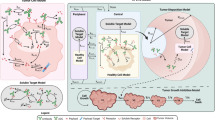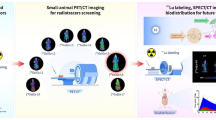Summary
Platinum complexes are extremely active chemotherapeutic agents. A murine monoclonal antibody designated 1C1 was developed that binds to the thirdgeneration platinum complex methyliminodiacetato-trans-R,R-1,2-diamminocyclohexane platinum(II) (MIDP). Competitive enzyme-linked immunosorbent assay (ELISA) shows that antibody 1C1 binds preferentially to the 1,2-diamminocyclohexane (DACH) side-chain of the platinum complex, although non-DACH-containing platinum complexes can compete for binding at high concentrations. When tested against MCF-7 breast carcinoma cells, the 1C1-MIDP complex caused 50% growth inhibition at 0.63 μg Pt/ml, whereas MIDP alone caused 50% growth inhibition at a concentration of 0.16 μg Pt/ml. Pharmacokinetic studies in rats using [3H]-MIDP showed that the drug was cleared triphasically from plasma, with elimination-phase half-lives (t1/2) of 1.2, 10.2, and 243 min for α, β, and γ phases, respectively. The MIDP-1C1 complex was cleared with longer half-lives of 5, 26, and 291 min, respectively. The overall clearance rate from plasma of the MIDP-1C1 complex was 10-fold lower than that of MIDP alone (0.37 vs 3.01 ml/kgxmin). Tissue concentrations of [3H]-MIDP 3 h after administration showed that 1C1 antibody prevented MIDP distribution to most organs and dramatically reduced [3H] concentration in the intestine, liver, kidney, heart, and skeletal muscles. Studies are under way to determine the relative therapeutic activity of the 1C1 antibody-MIDP complex and assess whether the 1C1 antibody may be useful for antibodydirected delivery of platinum complexes to tumors.
Similar content being viewed by others
Abbreviations
- MIDP :
-
methyliminodiacetato-trans-R-R-1,2-diamminocyclohexane platinum(II)
- MTT :
-
2,5-diphenyltetrazolium bromide thiazolyl blue
References
Aggarwal SK, Whitehouse ME, Ramachandran C (1980) Ultrastructural effects of cisplatin. In: Prestayko AW, Crooke ST, Carter SK (eds) Cisplatin: current status and new developments. Academic, New York, p 79
Aull JL, Allen RL, Bupat AR, Daron HH, Friedman ME, Wilson JF (1979) The effects of platinum complexes on seven enzymes. Biochem. Biophys Acta 571:352–358
Carter SK (1978) The clinical evaluation of analogues: I. The overall problem. Cancer Chemother Pharmacol 1:69–72
Chu BCF, Whiteley JM (1977) High molecular weight derivatives of methotrexate as chemotherapeutic agents. Mol Pharmacol 13:80–88
Dillman RO, Shawler DL, Johnson DE, Meyer DL, Koziol JA, Frincke JM (1986) Preclinical trials with combinations and conjugates of T101 monoclonal antibody and doxorubicin. Cancer Res 46:4886–4891
Drobnik J (1983) Antitumor activity of platinum complexes. Cancer Chemother Pharmacol 10:145–149
Einhorn LH (1981) Testicular cancer as a model for a curable neoplasm: the Richard and Hinda Rosenthal Foundation Award lecture. Cancer Res 41:3275–3280
Goding JW (ed) (1983) Monoclonal antibodies: principles and practice. Academic, Orlando, pp 1–276
Goldenberg DM, Kim EE, DeLand FH, Nagell van JR Jr, Javadpour N (1980) Clinical radioimmunodetection of cancer with radioactive antibodies to human chorionic gonadotropin. Science 208:1284–1286
Goldenberg DM, Kim EE, DeLand F, Spremulli E, Nelson MO, Glockerman JP, Primus FJ, Corgan RL, Alpert E (1980) Clinical studies on the radioimmunodetection of tumors containing alpha-fetoprotein. Cancer 45:2500–2505
Green LM, Reade JL, Ware CF (1984) Rapid colorimetric assay for cell viability: application to the quantitation of cytotoxic and growth inhibitory lymphokines. J Immunol Methods 70:257–268
Haber E (1983) Antibodies as models for rational drug design. Biochem Pharmacol 32:1967–1977
Hacker MP, Douple EB, Krakoff IH (eds) (1984) Platinum coordination complexes in cancer chemotherapy. Martinus Nijhoff, Boston, pp 1–384
Hacker MP, Khokhar AR, Brown DB, McCormack JJ, Krakoff IH (1985) Ascorbato (1,2-diaminocyclohexane): platinum(II) complexes, a new series of water-soluble antitumor drugs. Cancer Res 45:4748–4753
Hall IH, Holshouser MH, Loeffler LI (1980) Effects ofcis-malonato-diammino platinum(II) on P-388 lymphocytic leukemia cell metabolism. J Pharm Sci 69:1160–1163
Harrap KR (1983) Platinum analogues: criteria for selection. In: Muggia FM (ed) Cancer Chemotherapy, vol 1. Martinus Nijhoff, Boston, pp 171–217
Kerrison SJS, Sadler PJ (1981) Coordination of amides tocis-di ammino di aqua platinum(II) complex. J Chem Soc Chem Commun 2:61–62
Kohler G, Milstein C (1975) Continuous cultures of fused cells secreting antibody of predefined specificity. Nature 256: 495–497
Larson SM, Brown JP, Wright PW, Carrasquillo JA, Hellstrom I, Hellstrom KE (1983) Imaging of melanoma with I131 labeled monoclonal antibodies. J Nucl Med 24:123–129
Larson SM, Carrasquillo JA, Krohn KA, McGuffin RW, Williams DL, Hellstrom I (1983) Diagnostic imaging of malignant melanoma with radiolabeled antitumor antibodies. JAMA 249:811–812
Levi J, Jacobs C, Kalman SM, McTigue M, Weiner MW (1980) Mechanism ofcis-platinum nephrotoxicity: I. Effects of sulfhydryl groups in rat kidneys. J Pharm Exp Ther 213: 545–550
Levi-Schaffer F, Bernstein A, Meshorer A, Arnon R (1982) Reduced toxicity of daunorubicin by conjugation to dextran. Cancer Treat Rep 66:107–114
Lippman AJ, Helson C, Helson L, Krakoff IH (1973) Clinical trials ofcis-diamminedichloroplatinum (NSC-119875). Cancer Chemother Rep 57:191–200
Murray JL, Rosenblum MG, Sobol RE, Bartholomew RW, Plager CE, Haynie TP, Jahns MF, Glenn HJ, Lamki L, Benjamin RS, Papadopoulos N, Boddie AW, Frincke JM, David GS, Carlo DJ, Hersh EM (1985) Radioimmunoimaging in malignant melanoma with111In-labeled monoclonal antibody 96.5. Cancer Res 45:2376–2381
Newman RA, Khokhar AR, Sunderland BA, Travis EL, Bulger RE (1986) A comparison in rodents of renal and intestinal toxicity of cisplatin and a new water-soluble antitumor platinum complex:N-methyl-iminodiacetato-diaminocyclohexane platinum(II). Toxicol Appl Pharmacol 84:454–463
Rahn RO, Johnson NP, Hsie AW, Lemontt JF, Masker WE, Recan JD, Dunn WC, Hoeschele JD, Brown PH (1980) Interaction of platinum compounds with the genome-correlation between DNA binding and biological effects. In: Witschi HR (ed) The scientific basis of toxicity assessment. Elsevier-North Holland, Amsterdam, p 153
Rosenblum MG, Unger BW, Gutterman JU, Hersh EM, David GS, Frincke JM (1985) Modification of human leukocyte interferon pharmacology with a monoclonal antibody. Cancer Res 45:2421–2424
Siddik ZH, Boxall FE, Harrap KR (1987) Flameless atomic absorption spectrophotometric determination of platinum in tissues solubilized in hyamine hydroxide. Anal Biochem 163: 21–26
Stickney DR, Frincke JM, Slater JB, Ahlem CN, Merchant B, Slater JM (1988) Third International Conference on Monoclonal Antibody Immunoconjugates for Cancer, February 4–6, San Diego, California
Thorpe PE, Brown AN, Ross WC, Cumber AJ, Detre SI, Edwards DC, Davies AJS, Stirpe F (1981) Cytotoxicity acquired by conjugates of an anti-Thy 1.1 monoclonal antibody and the ribosome-inactivity protein, gelonin. Eur J Biochem 116: 447–454
Von Hoff DD, Schilsky R, Reichert CM, Reddick RL, Rozencweig M, Young RC, Muggia FM (1979) Toxic effects ofcis-dichlorodiammineplatinum(II) in man. Cancer Treat Rep 63:1527–1537
Author information
Authors and Affiliations
Additional information
Supported in part by NIH grant CA 41581 to ARK
Rights and permissions
About this article
Cite this article
Rosenblum, M.G., Murray, J.L., Stuckey, S. et al. Modification of methyliminodiacetato-trans-R, R-1,2-diamminocyclohexane platinum(II) pharmacology using a platinum-specific monoclonal antibody. Cancer Chemother. Pharmacol. 25, 405–410 (1990). https://doi.org/10.1007/BF00686050
Received:
Accepted:
Issue Date:
DOI: https://doi.org/10.1007/BF00686050




